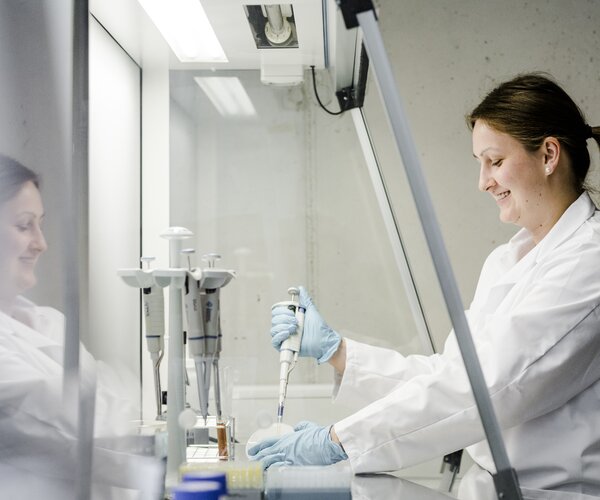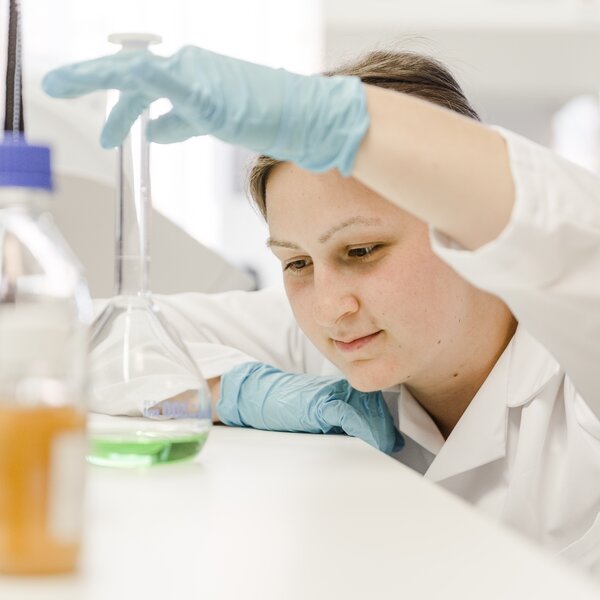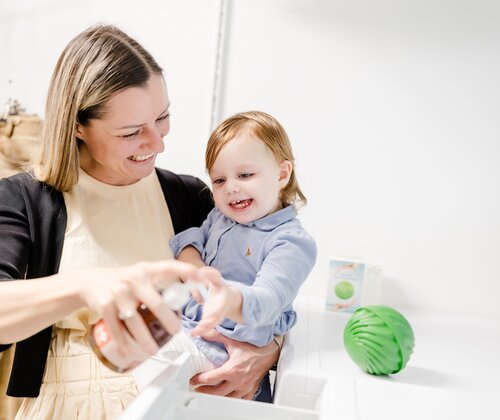
Research guarantees our innovative strength
Research and development form the backbone of Multikraft's innovative strength. In conversation with Dr Katharina Kraxberger, Head of Research & Development and Quality Management, it becomes clear how intensively the company is working on sustainable solutions. She provides insights into current trends in cleaning agent research, explains the development process for new products, talks about the role of microorganisms and shows the opportunities that modern databases open up for the future.

In conversation with Katharina Kraxberger
What are the current trends in cleaning product research?
Research into probiotic cleaning products has become increasingly important in recent years, as they are said to offer environmentally friendly, sustainable and ecological alternatives to conventional cleaning products. Studies show that they can increase microbiological diversity on surfaces while reducing the spread of antibiotic resistance genes. Their potential is being investigated, particularly in sensitive areas such as hospitals.
Critics argue that the cleaning effect may be due to chemical components such as acids or alcohols rather than the probiotic microorganisms themselves. Despite these debates, the results so far show promising approaches that warrant further research.
What are the current trends in cleaning product research?
Research into probiotic cleaning products has become increasingly important in recent years, as they are said to offer environmentally friendly, sustainable and ecological alternatives to conventional cleaning products. Studies show that they can increase microbiological diversity on surfaces while reducing the spread of antibiotic resistance genes. Their potential is being investigated, particularly in sensitive areas such as hospitals.
Critics argue that the cleaning effect may be due to chemical components such as acids or alcohols rather than the probiotic microorganisms themselves. Despite these debates, the results so far show promising approaches that warrant further research.
What are the main objectives of research in the field of probiotic cleaning agents?
The aim is to create sustainable, safe and effective alternatives for private, industrial and medical applications. The top priority is to promote a healthy microbial balance – in other words, to colonise surfaces with healthy microorganisms in order to displace pathogenic germs.
Other key areas of focus include:
- Reducing antibiotic resistance
- Developing environmentally friendly and biodegradable products
- Long-term cleaning effects through continuous dirt breakdown
- Improving indoor health
- Maximising cleaning efficiency
What makes the ingredients in Multikraft cleaners so valuable?
Multikraft cleaners are based on a careful selection of bacterial strains as well as regional, fermentation-based components such as organic lemon verbena leaves and organic glucose syrup from Austrian sugar beet. These are therefore particularly natural ingredients.
The surfactants have also been very carefully selected. These are two biologically approved surfactants made from renewable raw materials such as glucose and vegetable oils. These ensure strong grease-cutting power and excellent cleaning performance. Thanks to the careful selection, the cleaning agents are gentle on the skin and do not require any hazard symbols. Skin compatibility has been dermatologically tested by an external institute and awarded the rating ‘very good skin compatibility’.
Where do you see the biggest advantages of Multikraft cleaners?
The new cleaners stand out thanks to their innovative properties and versatile benefits. They promote a positive microclimate, neutralise unpleasant odours and have a lasting effect by reducing and preventing deposits in drain pipes, for example. They also combat limescale and gently remove stains without damaging sensitive surfaces.
Another advantage is that they leave shiny, clean results and reduce re-soiling. Their high efficiency makes them economical to use and therefore cost-effective. Thanks to their natural and harmless ingredients, they are particularly environmentally friendly and ideal for households with children and pets.
The new cleaners stand out thanks to their innovative properties and versatile benefits. They promote a positive microclimate, neutralise unpleasant odours and have a lasting effect by reducing and preventing deposits in drain pipes, for example. They also combat limescale and gently remove stains without damaging sensitive surfaces.
Another advantage is that they leave shiny, clean results and reduce re-soiling. Their high efficiency makes them economical to use and therefore cost-effective. Thanks to their natural and harmless ingredients, they are particularly environmentally friendly and ideal for households with children and pets.
How does the research process work when developing new cleaning products?
Research into cleaning agents follows a systematic, multi-step approach to ensure effectiveness, safety and environmental compatibility. First, we had to identify the requirements and set goals that meet certain standards. We were then able to select and test potential suitable ingredients such as microorganisms or surfactants.
This was followed by laboratory studies to produce various prototypes and tests of cleaning power, material compatibility and stability. Initial microbiological tests were also carried out at this stage. Application tests on various surfaces under real conditions followed, and the formulations were continuously improved and optimised. Criteria for this included cleaning performance, yield, consistency, handling and odour. Once the formulation had been finalised, we turned our attention to various certifications, approvals and finally the market launch.
Research into cleaning agents follows a systematic, multi-step approach to ensure effectiveness, safety and environmental compatibility. First, we had to identify the requirements and set goals that meet certain standards. We were then able to select and test potential suitable ingredients such as microorganisms or surfactants.
This was followed by laboratory studies to produce various prototypes and tests of cleaning power, material compatibility and stability. Initial microbiological tests were also carried out at this stage. Application tests on various surfaces under real conditions followed, and the formulations were continuously improved and optimised. Criteria for this included cleaning performance, yield, consistency, handling and odour. Once the formulation had been finalised, we turned our attention to various certifications, approvals and finally the market launch.
What have the latest studies revealed?
All of our cleaners recently underwent standardised dermatological testing to determine their skin compatibility. As part of an external patch test, 30 test subjects were examined in an in vivo study. The results showed no evidence of skin irritation when used properly. The skin compatibility of our cleaners was rated as ‘very good’ overall.
What other areas of research are currently the focus of Multikraft?
In order to maintain and continuously develop our high quality standards, we work closely with scientists from research centres, technical colleges, universities and other academic institutions worldwide.
A current focus in agriculture is on researching bacteria that can potentially break down pesticide residues. In horticulture, we are concentrating on developing effective solutions for combating fungal diseases. These innovative approaches underline our commitment to sustainable and practical solutions.


How is the quality and effectiveness of the microorganisms in Multikraft products ensured?
The microorganisms are stored long-term at –80 °C under special conditions to ensure their stability and vitality. For later use, they undergo a multi-stage propagation process.
During propagation, each individual step is carefully monitored, such as checking for possible contamination, to ensure that only the desired microorganisms are retained in high purity. At the same time, the concentration of bacteria is continuously measured to guarantee consistent quality and effectiveness.
How advanced are microorganism databases and what does this have to do with Multikraft?
The development of microorganism databases has made significant progress in recent years. A leading example is BacDive, the Bacterial Diversity Database, which is one of the largest global databases. It already contains data on over 99,000 strains.
Multikraft also operates its own database, in which we collect and analyse data from isolated strains from the environment and our products. Among other things, we document:
- Location, growth medium and growth conditions,
- Genome and characteristics of the strains,
- Long-term storage to ensure constant availability.
The Multikraft database for our MK Boden product currently contains over 160 bacterial strains.
What are the advantages of systematically collecting microorganisms in databases, and what opportunities does this open up for the future?
Extensive microorganism databases offer numerous advantages. They represent a centralised and standardised source of information that enables researchers to access data quickly and reliably. This greatly facilitates the identification and classification of microorganisms, while improving the comparability and reproducibility of studies.
In the future, they could help solve global challenges – for example, by identifying microbes for pollution control or climate protection. They also enable advances in personalised medicine and sustainable agriculture by allowing specific microorganisms to be used in a targeted manner.
Thank you very much for talking to us, Katharina!
Extensive microorganism databases offer numerous advantages. They represent a centralised and standardised source of information that enables researchers to access data quickly and reliably. This greatly facilitates the identification and classification of microorganisms, while improving the comparability and reproducibility of studies.
In the future, they could help solve global challenges – for example, by identifying microbes for pollution control or climate protection. They also enable advances in personalised medicine and sustainable agriculture by allowing specific microorganisms to be used in a targeted manner.
Thank you very much for talking to us, Katharina!



